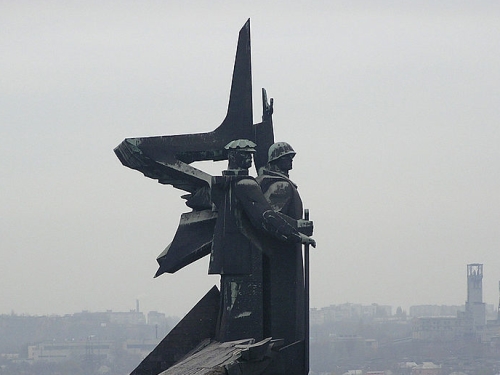
This article was originally published by the Carnegie Moscow Center on 17 November 2014.
Russia is invading Ukraine, again. As usual, the Russian Ministry of Foreign Affairs has refuted hard evidence from journalists and international observers. Both NATO and the OSCE have confirmed that heavy weaponry and combat troops are moving to Donbas from Russia. A detailed look suggests that although the ceasefire has been seriously violated (again), what we see is mostly a tactical operation aimed at reinforcing rebel positions, not preparation for a full-fledged war.
What has changed? After parliamentary elections in Ukraine on October 26 and separatist-held quasi-elections in Donbas on November 2, the leadership in both regions seems stable for the first time in months. The goals of the elections in Kyiv and the votes in Lugansk and Donetsk were essentially the same: to gain political legitimacy. Moscow recognized the former and “respected” the latter (stopping short of outright recognition), calling for dialogue between Kyiv and the two separatist republics. Held without Kyiv’s endorsement, the separatist elections contravened the Minsk agreement and may ultimately undermine the sort-of-peace that has existed in Ukraine’s east for the past two and a half months. Even the cautious and diplomatic OSCE has admitted that the ceasefire is, for all intents and purposes, dead.
Moscow is pursuing several objectives. Firstly, it wants to create a land corridor between East Ukraine and Crimea. The Donbas elections did not advance efforts for a united Novorossiya. In fact, quite the opposite: it appears as the cleaning out of true Novorossiya fans. The situation in Crimea is becoming direr by the day, as Russia remains unable to deliver supplies without assistance from Ukraine’s authorities. Food prices are skyrocketing, and the Kerch strait, which was an ineffective transport route even during the summer, will soon be frozen. However, last week, the peninsula resumed receiving food supplies from mainland Ukraine. To ensure a land corridor to Crimea, Russia will need a much more sizeable military force. Currently, NATO estimatesthat there are only about 300 Russian soldiers in the Donbas.
Secondly, Moscow wants to militarily stabilize the separatist republics’ gains. Two parts of the frontline have been particularly violent recently: Debaltseve, an earlier Ukrainian advance, and heavy fighting continues near the Donetsk Airport. If rebels take control of these areas, the frontline may be frozen for the winter, and the separatists’ territory could be easier to defend. The Ukrainian government seems to be preparing for such a freeze. However, the Donetsk Airport, which no longer has any strategic value but retains great symbolic meaning due to the ongoing heroic defense by Ukrainian troops, will not be easy to give up. Mariupol, a key port city on the Azov Sea, remains in tenuous Ukrainian control. Given the size of the city and the Ukrainian military buildup in the surrounding areas, the rebels and their Russian backers may hold off on any attacks.
Thirdly, the Kremlin wants to ensure political control over the Donbas. Numerous reports suggest infighting among rebels in Donetsk and Lugansk. Businesses in rebel-controlled parts of Lugansk have stopped operating. Separatist behavior is cause for alarm in Washington and in Moscow—even though the latter cannot admit it. The sudden departure of Igor Bezler, notorious for his alleged role in the shootdown of MH17, opposed the now “elected” Donetsk Prime Minister Aleksandr Zakharchenko, which gives the impression of instability among the new political elite in the Donbas. As revealed by a recent interview with Alexander Borodai, the first “Prime Minister” of Donetsk, Bezler was forced out because he did not fit into the developing political establishment in the Donbas. Igor Strelkov stroked back that Borodai is the Kremlin agent. For Moscow to ensure the implementation of the Minsk protocols, it needs to assert more control locally.
Last but not least, Russia is left with few good political options in Ukraine. Its main lever of influence is the threat of continued war. Ukraine is in the process of forming a new ruling coalition and a new government. President Putin has a say in the development of this process by threatening an invasion. He can now be almost certain that the West will not go to war with Russia over Ukraine. He is not afraid of sanctions, and may even believe that the Russian people will rally around the government.
What’s more, Russia and Ukraine are locked in a spiral of economic decline. This may lead to the fragmentation of political control and encourage infighting as internal pressure on both sides builds up, especially since Ukraine’s armed forces and political leadership remain in disarray. No wonder that the disagreement about the minister of interior portfolio led the coalition talks into a deadlock.
Given the vulnerability of the economic, social, and political situation in Ukraine, the West may not have a better solution than to accept to freeze Donbas for the winter—even though it can’t admit this.
Balázs Jarábik is a visiting scholar at the Carnegie Moscow Center focusing on Ukraine and Eastern Europe.
For more information on issues and events that shape our world, please visit ISN Security Watch or browse our resources.

